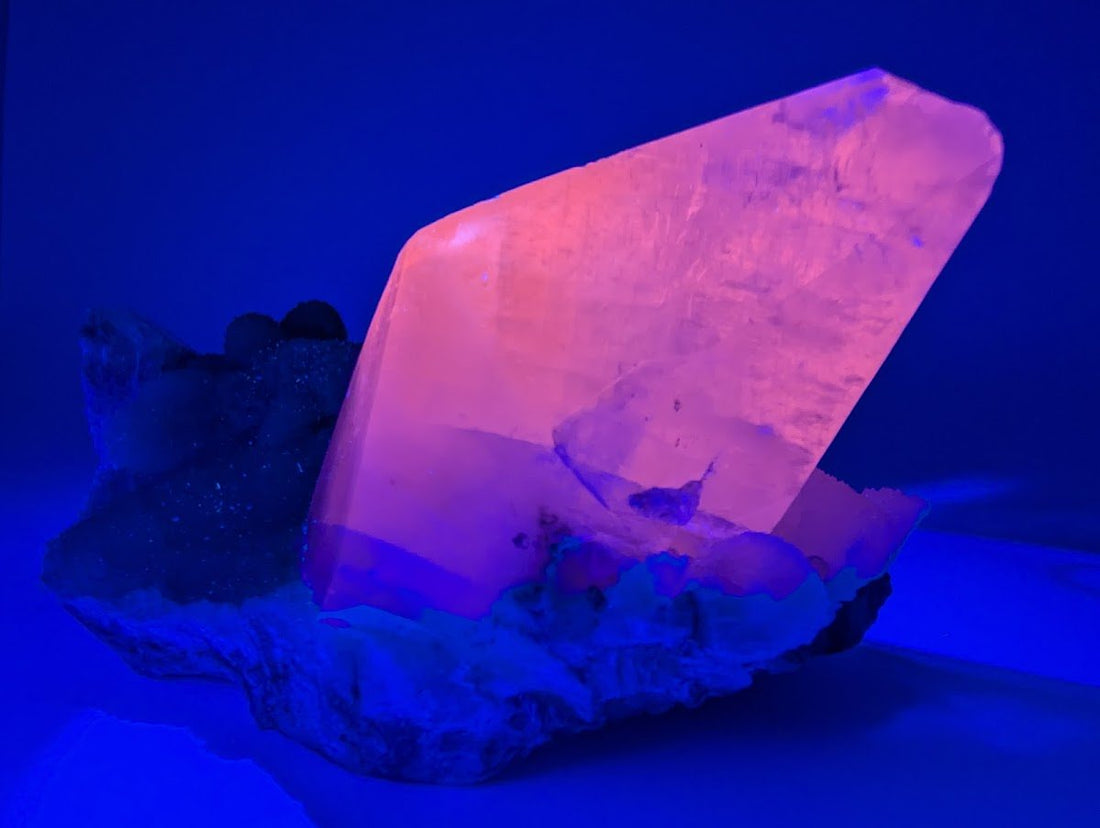
Why Some Crystals Fluoresce Under UV Light
Share
Glowing minerals aren’t just beautiful — they’re a clue to something deeper. From calcite that turns neon to fluorite that glows electric purple, fluorescence connects the invisible energy of ultraviolet light with the inner chemistry of crystals. But why does it happen? And what does it mean for collectors?
What Is Fluorescence in Crystals?
Fluorescence is the phenomenon where a crystal absorbs invisible ultraviolet (UV) light and re-emits it as visible color. The effect happens instantly under a blacklight or UV lamp — and disappears the moment the light is turned off.
Not all crystals fluoresce. Those that do contain specific impurities (called “activators”) — like manganese, lead, or rare earth elements — that respond to UV light in a unique way.
Common Fluorescent Crystals
- Fluorite: Usually glows blue, purple, or cream under UV — especially specimens from Rogerley (UK), Illinois (USA), or China
- Calcite: Can fluoresce red, orange, pink, or white depending on locality and chemistry
- Willemite: Bright green under shortwave UV — famous from Franklin, New Jersey
- Scheelite: Glows pale blue under shortwave UV — a helpful tool in mining for tungsten
- Autunite: A uranium-bearing mineral with bright green-yellow fluorescence
- Hackmanite: Can glow pink or purple and also exhibits tenebrescence (color changes when exposed to light)
- Petroleum-Included Fluorite: Clear fluorite with yellow oil inclusions that fluoresce bright blue or yellow under UV. Often from Pakistan or China — a favorite among fluorescence collectors.
What Causes Fluorescence?
Fluorescence is caused by trace elements or defects in a crystal’s atomic structure. These imperfections absorb UV energy and re-emit it as visible light. The color depends on the type of activator and the host mineral.
For example:
- Manganese can cause pink or red fluorescence in calcite
- Rare earth elements may create green or yellow in fluorite
- Lead is a common activator in scheelite and some fluorites
Some inclusions — like petroleum — fluoresce independently from the host crystal. In petroleum fluorite, it’s not the fluorite that glows, but the trapped oil droplets inside.
The same mineral may fluoresce differently depending on where it's from — which is why locality is so important for fluorescence collectors.
Fluorescence vs. Phosphorescence
While fluorescence stops glowing when the UV light is removed, phosphorescence means the crystal continues glowing for a few seconds (or longer) after the light is turned off. Some fluorites and calcites show this effect.
Why Collectors Love Fluorescent Crystals
Fluorescence adds an entirely new dimension to a specimen — turning something ordinary into a light show under UV. For collectors, this means:
- ✨ Two-in-One Beauty: One appearance in daylight, another under UV
- 🌐 Locality Clues: Glowing patterns can help verify where a mineral came from
- 📸 Visual Impact: Incredible for photography, display cases, and educational collections
Metaphysical Perspectives on Fluorescent Stones
Some energy workers believe fluorescent crystals carry “hidden light” energy — supporting transformation, awakening, and soul-level healing. They're thought to help:
- 🕯️ Reveal what’s hidden (emotionally or energetically)
- 🌑 Work in shadow or dream work
- 🌠 Spark intuition, inner vision, and awakening
Whether you believe in their energetic effects or not, their ability to change under unseen light makes them powerful symbols of revelation and insight.
Legacy’s Approach to Fluorescent Crystals
At Legacy Crystals and Minerals, we test specimens under both longwave and shortwave UV light — and clearly note if a piece has strong or subtle fluorescence. We also highlight localities known for UV performance like:
FAQs About Fluorescent Crystals
💡 Do all crystals fluoresce under UV light?
No — only certain minerals fluoresce, and even within the same type (like fluorite), fluorescence can vary by locality and composition.
💡 What type of UV light should I use to test fluorescence?
Collectors often use longwave (365nm) and shortwave (254nm) UV lights. Some minerals respond better to one than the other, so dual-mode lamps are ideal.
💡 Is fluorescence the same as glow-in-the-dark?
No. Fluorescence only occurs while UV light is shining. Glow-in-the-dark materials (phosphorescent) continue glowing after the light is off.
💡 Can I damage a crystal by exposing it to UV light?
Most fluorescent minerals are safe to expose to UV in short sessions. However, avoid prolonged UV exposure to delicate or UV-sensitive crystals like amethyst, which may fade over time.
💡 Do fluorescent crystals have different metaphysical meanings?
Some practitioners believe they do — viewing fluorescence as a symbol of hidden insight, intuition, or transformation. Others see it as an aesthetic bonus. It’s up to your practice and perspective.
Final Thoughts: Light Beneath the Surface
Fluorescence is one of nature’s most surprising gifts — a secret light that only reveals itself when the conditions are just right. Whether you're drawn to it for science, symbolism, or simple joy, fluorescent crystals remind us that there is always more than meets the eye.



